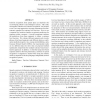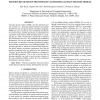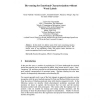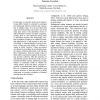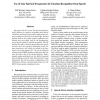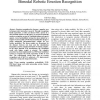ACII
2011
Springer
13 years 13 days ago
2011
Springer
Communication between humans is rich in complexity and is not limited to verbal signals; emotions are conveyed with gesture, pose and facial expression. Facial Emotion Recognition ...
FGR
2011
IEEE
13 years 3 months ago
2011
IEEE
— This work details the authors’ efforts to push the baseline of expression recognition performance on a realistic database. Both subject-dependent and subject-independent emot...
ICASSP
2011
IEEE
13 years 4 months ago
2011
IEEE
Emotion recognition from speech plays an important role in developing affective and intelligent systems. This study investigates sentence-level emotion recognition. We propose to ...
ICMCS
2009
IEEE
13 years 10 months ago
2009
IEEE
Gaussian mixture models (GMMs) and the minimum error rate classifier (i.e. Bayesian optimal classifier) are popular and effective tools for speech emotion recognition. Typically, ...
HCI
2009
13 years 10 months ago
2009
In this article, we address some of the issues concerning emotion recognition from processing physiological signals captured by bio-sensors. We discuss some of our preliminary resu...
ACL
2009
13 years 10 months ago
2009
In this paper we describe the Rovereto Emotive Corpus (REC) which we collected to investigate the relationship between emotion and cooperation in dialogue tasks. It is an area whe...
ICPR
2010
IEEE
13 years 10 months ago
2010
IEEE
We propose the use of the line spectral frequency (LSF) features for emotion recognition from speech, which have not been been previously employed for emotion recognition to the b...
RIA
2006
14 years 10 days ago
2006
In this article, we expose our research program in bio-affective-social computing aimed at guiding and participating to the development of multimodal socially intelligent agents in...
PAMI
2008
14 years 11 days ago
2008
Little attention has been paid so far to physiological signals for emotion recognition compared to audiovisual emotion channels such as facial expression or speech. This paper inve...
JCP
2008
14 years 12 days ago
2008
Emotion recognition has become a popular area in human-robot interaction research. Through recognizing facial expressions, a robot can interact with a person in a more friendly man...

